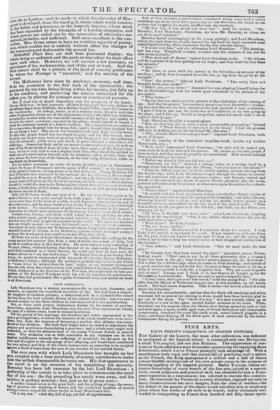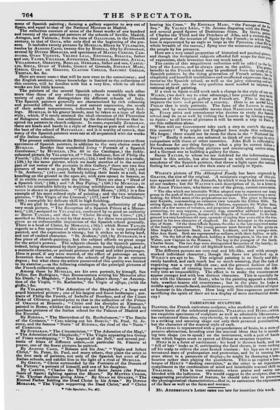FINE ARTS.
LOUIS PHILIP'S COLLECTION OF SPANISH PICTURES.
THE Gallery of the Louvre, like most other collections, was deficient in specimens of the Spanish school : it contained only two MuRILLOR, a small VELABQUEZ, and one fine RIBIERA. The suppression of con- vents in Spain afforded a most favourable opportunity for supplying these deficiencies, which Louts PHILIP promptly took advantage of. With a Munificence truly regal, and that cannot fail of gratifying such a nation as the French, the King appropriated a million and a half of francs (about 60,0001. sterling) out of his own private purse to the purpose of forming a gallery of the Spanish pictures. Baron TAYLOR, whose ex- tensive knowledge of every branch of the fine arts, joined to a correct taste, sound judgment, and practical skill, has obtained for him a Euro- pean reputation as a connoisseur, was selected to execute this commis- sion. He traversed the Peninsula in every direction, exposed not only to many inconveniences but even dangers, from the state of warfare—tor his ardour in the pursuit of his object would not allow him to avoid any place where fine works of art were to be found; and he ultimately suc- ceeded in trau.sperting to France four hundred and fifty elsoiee speck-
mens of Spanish painting ; forming a gallery superior to any out of Spain, and equal to that of the National Museum at Madrid. The collection consists of some of the finest works of one hundred and twenty of the principal painters of the schools of Seville, Madrid, Arragon, and Valencia ; from the time of GALLIEGOS, in the fifteenth century, to that of GOY*, who only died at the beginning of the pre- sent. It includes twenty pictures by MURILLO, fifteen by VELASQUEZ, twelve by Atoiszo CANO, twenty-five by RIBIF.RA, fifty by ZURBARAN, several by DIVINO MORALES, and specimens of 1JATE0 CEREZO, CAR- DUCHO, GUAN VICENTE, VALDEZ LEAL, ESPINOZA, RIBALTA, father and son, YANES, VILLEGAS, ANTONINES, MENESEZ, SESPEDEZ, AYALA, VILLADOMAT, ORRENTE, ROELAS, HERRARA, father and son, CASTIL- L10, SIEZA, GUAN of Toledo, GOMEZ of Grenada, ESTEBAN MARC, GRECO, GUAN DE GOANES, CLAUDIO COELLO, SANCHEZ COELLO, TRISTAN, &C. 8Ie.
Here are many names that will be new even to the connoisseur ; and the English amateur, whose knowledge is limited to the collections of this country, will be familiar with but a very few, while to all their works are but little known.
The painters of the several Spanish schools resemble each other more than those of any other country; there is nothing like that variety of style that distinguishes the different schools of Italy. The Spanish painters generally are characterized by rich colouring and powerful effect, and intense and earnest expression, the result of their ardent temperament, influenced by strong religious feel- ings. Mums°, in his graver ;mods, may be taken as a type of their style ; which, if it rarely attained the ideal elevation of the Florentine or Bolognese schools, was sublimed by the devotional fervour that in- spired the painters in church subjects. In some, especially ZURBARAN, there are heads and hands in a style of drawing as pure and refined as the best of the school of RAFfAELLE : and it is worthy of remark, that many of the Spanish painters were not at all acquainted with the works of the Italian schools.
The present exhibition at the British Institution contains two or three specimens of Spanish painters, in addition to the very choice ones of Idexitto. Besides that wonderful living " Portrait of a Spanish Gentleman," by MURILLO, (No. 60 in the Catalogue,) the richly- coloured picture, by VELASQUEZ, of" Don Balthazar, Son of Philip the Fourth," (25,) the equestrian portrait, (1540 and the infant in a cradle, (1390 by the same painter, which we made mention of in the second part of our notice of the portraits in this Gallery,' there are two fine pictures of monks at prayer, by Muatt.r.o—" St. Francis," (18,) and " St. Anthony," (54)—not listlessly telling their beads in a cell, but kneeling on the ground in the open air, with eyes upcast to heaven, as if in visible communion with the Deity. There are also a" Head of a Spanish Girl," (100,) and "A Boy Piping," (108,) by Meaux° ; in which his inimitable felicity in depicting mirthfulness and rustic cha- racter is shown in perfection. " The Infant Moses," (103,) is a fine example of his most refined style of painting ; and the two miniature pictures, " The Virgin of the Crescent," (177,) and "The Crucifixion," (168,) exemplify his delicate skill in high finishing.
We are glad to find our doubts respecting the authenticity of that very weak picture, ."flie Reception of a Spanish Prince at a Monas- tery," (50,) assigned to VELASQUEZ, confirmed by so good an authority as Baron TAYLOR; and that the " Christ Briring his Cross," (28,) ascribed to MORALES, is not by that master ; fc.r these two pictures had given us an unfavourable impression of the Spanish school generally. There is a head of Christ, by Moantr.s, (165,) which Baron TAYLOR regards as a fine specimen of this artist's style ; it is very powerfully painted, and the expression is strong ; but it strikes us as being hard, and not of exalted character. " St. Andrew," (63,) by ZURBARAN, is a fine piece of church-painting; but the subject affords no great scope for the artist's powers. The subjects chosen by the Spanish painters, indeed, being determined by their patrons, were mostly religious, and of a monastic character, or portrait pictures of royal and other personages. Here is proof, if any were wanted, of the effect of patronage on art. Invention does not characterize the schools of Spain in an eminent degree ; but what share the artists possessed of this quality was limited in its exercise ;—as the following catalogue of the principal pictures of the French collection shows.
Among those by MURILLO, are his own portrait, by himsslf, San Felice, San Rodriguez, "San Buonaventura writing his Memoirs after
his Death," a Magdalen, "Jacob keeping Luban's sheep," an Assump- tion of the Virgin, "St. Katharine," the Virgin at affitga, (with the girdle,) &c.
By VELASQUEZ, "The Adoration of the Shepherds ;" a large and grand historical picture ; one of his largest and finest landscapes ; por- traits of Philip the Fourth, of Isabella of Bourbon, and of the Count Duke of Olivarez, painted prior to that in the collection of the Prince of ORANGE at Brussels ; "Christ and his disciples at Emmaus," painted in Rome, whither the artist was sent by PHILIP the Fourth to purchase pictures of the Italian school for the Palaces of Madrid and the Escurial.
By RIBIERA, " The Martyrdom of St. Bartholomew," "The Battle of the Centaurs," "Cato tearing out his Bowels," St. Paul, St. Je- rome, and the famous " Notte " of Rialeaa, the rival of the " Notte " Of CORREGIO.
By ZURBARAN," The Circumcision," " The Adoration of the Magi," "The Adoration of the Shepherds," "The Virgin appearing to a Group of Friars worshipping," "The Legend of the Bell," and several por- traits of friars of different orders,—in particular St. Francis at prayer, one of the finest pictures he painted. By ALONZO CANO, "Balsam and his Ass," "Virgin and Infant Christ," St. Peter, St. Paul, and many others, that place the artist in the first rank of painters, not only of the Spanish but even of the Italian schools, and exhibit him in the light of a rival of MURILLO. By GRECO, "Christ surrounded by the Portraits of the Donors of the Picture," a portrait of himself, and one of his daughter. By CARENO, "Charles the Third and Saint James (the Patron Saint of Spain) fighting against the Moors." By MATTE° CERN°, "St. Thomas Aquinas giving Alms." By GUAN DE GUANES, "The
Eternal Father holding the Dead Christ in his Arms." By DIVINO AfORALIS, " The Virgin supporting the Dead Christ," and "Christ • Vide Spectatur, No. 467, bearing his Cross." By ESTEBAN MARC, "the Passage of the Sea." By VALDEZ LEA!., "St. Jerome disputing with the and several grand figures of Dominican friars. By Gova, ponk, of Charles the Third and the Dutchess of Alba, and a curious real picture of the invasion of Spain by the French ; in which leon is represented by an eagle as large as the Pyrenees, Doetc,l, (that fills"ti:•
whole breadth of the canvas,) flying over the mountains and t
ern ythi
the people by his presence.
Here are a very small proportion of historical and poetical picturi1. and though the Scriptural subjects afforded full scope for their y04' of expression, their invention was not much taxed. The entire of this magnificent collection will be added to the G. lery of the Louvre, and be always open to the public. The great„ benefits to the French school may be predicted from the study of tilt Spanish painters by the rising generation of French artists; for simplicity and heartfelt truthfulness and unaffected expression that eh, racterize the Spanish school, as well as the juicy colouring and ;1111. lowness of tone, are the very qualities most needed to improve kit national style of painting. If a visit to Spain ceuld work such a change in the style of our owl WILKIE, (we don't soy to what advantage,) how powerful may heti, influence of this Spanish gallery on French art. This is the wept& improve the taste acid genius of a country. Here is an scoff Lots Pinup that is truly patriotic. The fame of the Louvre is revini again, and by more honourable means than NAPOLLON Wok to enris, it. Every artist and connoisseur who desires to study the Spuiiii school may do so as well by visiting the Louvre as by ticking a voyegt to Spain : to all lovers of pictures it will be worth a trip to Paris to see this collection alone.
When will our Government take such a step to enrich the anted this country ? Why might not England have made this collection? We forget; there would not be room for them in the " National Ga. lery ! " Really it makes one ashamed to think of our doings in an is comparison with those of other countries. John Bull is ridiculed fot his fondness for tiny thing foreign : what a pity be cannot follow & French example in collecting pictures and encouraging native attic% and a German one in building a gallery for them.
Baron TAYLOR, to whom we are indebted for the information con. tamed in this article, has also favoured us with several interesting anecdotes of the Spanish painters, that throw a light upon the national feeling for art, and also on the then state of society in Spain.



























 Previous page
Previous page